Want to Maximize your Salesforce Investment?
We will teach you how to use CRM software to the fullest without overpaying for unnecessary functionality.
You must have heard about Salesforce at least once when looking for ways to optimize business processes. No wonder because Salesforce has been dominating the market for over 25 years and has extended into the vast ecosystem of different tools, apps, platforms, and solutions. So, what is Salesforce?
Salesforce is a Software-as-a-Service and platform-as-a-service company that has become the world’s #1 CRM system with a 20% market share. More than 150,000 companies trust Salesforce to manage their customer relationships, sales processes, and data.
They are always at the forefront of innovation for modernizing business processes. Salesforce is constantly developing new tools and releasing updates, and AppExchange is filled with more applications. Companies from the Fortune 500 are becoming new Salesforce acquisitions, and thousands are already Certified Salesforce Partners.
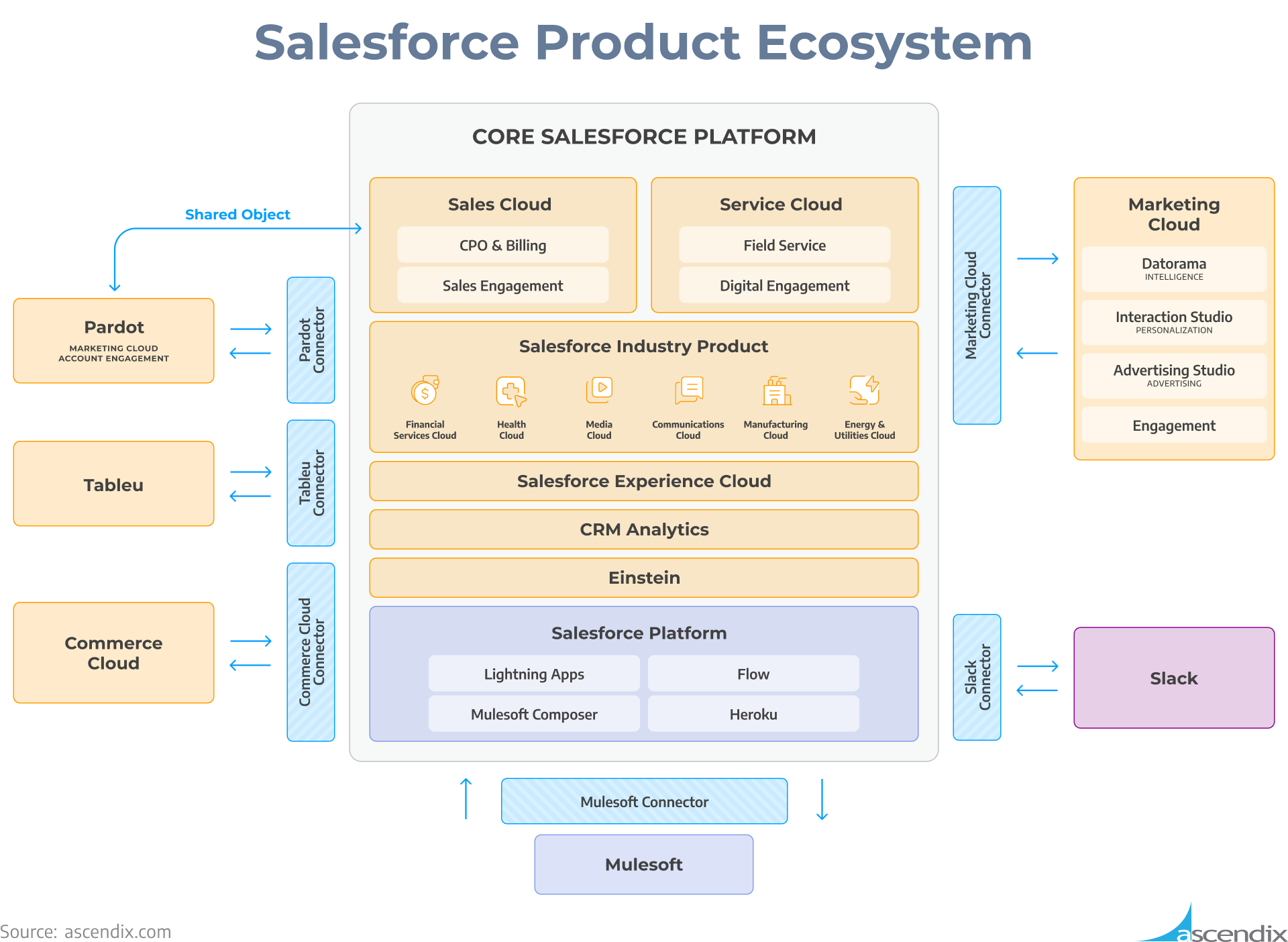
Salesforce Product Ecosystem | Ascendix
However, Salesforce is not the cheapest solution on the market and not the most beginner-friendly one. If you randomly dive into Salesforce, you risk feeling like you squandered money and time in vain. That’s why it’s important to get to know Salesforce’s features and benefits first.
The list of Salesforce features is much longer. Here are 10 Salesforce CRM modules to show how even basic features can help your business grow.
Contact and account management is the core of Salesforce CRM capabilities. Contact management implies recording contacts’ details and tracking their interaction with business. Important information about decision-makers, clients, partners, or other stakeholders is stored in one place. This pile of data can be segmented based on various criteria to launch targeted marketing campaigns and create easy-to-use structured databases. A bunch of contacts from one company are formed into account.
Account management is an important Salesforce capability that centers on retaining customers. You can track opportunities, cases, contacts, activities, and all possible interactions with an account. To manage enterprise-level accounts with many child companies, you can structure them into account hierarchies using parent-child relationships. Also, account management gives you a basis for proactive steps due to insights on overall account health, history of activity, and potential risks. This way, Salesforce helps to improve relationship management and increase retention and customer satisfaction.
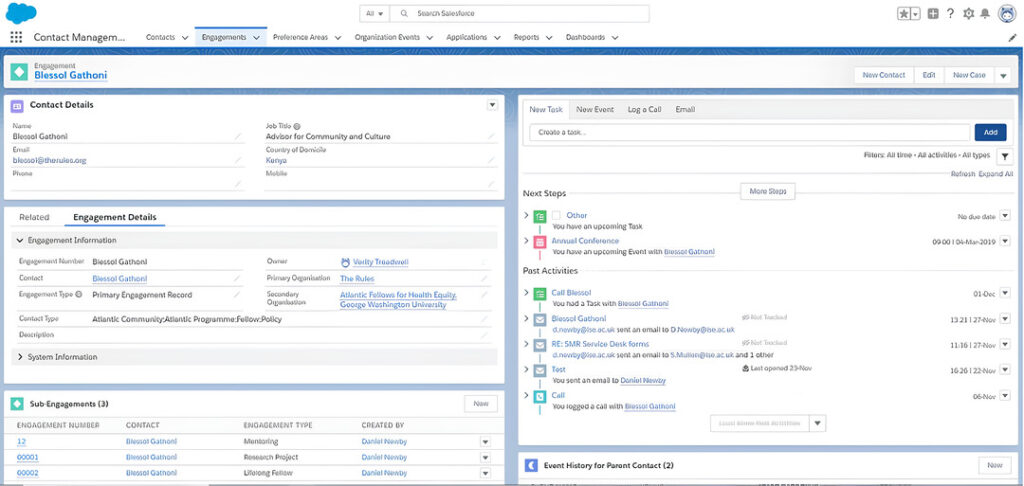
Contact management in Salesforce
Lead management includes lead capture, qualification, routing, and nurturing. An extremely convenient Salesforce feature here is web-to-lead, which allows gathering all necessary information about the potential customer from the built-in form on the website. This data is then automatically transferred to the Salesforce CRM.
Lead qualification and routing are the next steps. Proper lead scoring and qualifying based on predefined criteria ensure prudent effort prioritization on the most promising leads. This way, leads will be assigned to the most suitable sales reps according to their skills and fields of expertise. Sales teams can use Salesforce to send emails, set up meetings and reminders, and perform other lead nurturing activities so that no potential client falls through the cracks.
Interested leads are transferred to another category—opportunities. Opportunity management helps to structure the converting process of multiple leads. Supervising many things at a time can get confusing, but all the necessary communication history and contact data are stored and conveniently organized in Salesforce.
To facilitate dealing with prospects, Salesforce offers quote management features.
Quote Management includes automated quote generation, customization, tracking, and reporting. Automatically generated quotes always cover key aspects such as pricing, discounts, and terms and can be further customized to specific customer needs. Generating quotes is much faster than filing up necessary details manually, and setting up approval workflows streamlines the selling process even more.
We will teach you how to use CRM software to the fullest without overpaying for unnecessary functionality.
Approval automation implies verifying requests, granting discounts, or automated contact approval based on established rules and policies. The algorithm looks like “if condition A is fulfilled, action B is processed.” For example, if the quote is accepted, send the contact, or if the contact is not ready for purchase, add the contact to the email newsletter database.
The drag-and-drop functionality of the visual Lightning Flows makes creating schemes and rules easy and intuitive.
Workflow automation aims to reduce the sales team’s manual work, allowing them to redirect their resources to more necessary processes. Handy Salesforce features can automate or assist with tasks such as assigning leads, sending welcome emails, updating contact information, sending quotes, and more.
Activity Management is a key feature of Salesforce that allows users to manage tasks, events, and calendars efficiently within the platform.
Users can schedule tasks, assign tasks to team members, prioritize tasks, and track them through custom lists and dashboards. Tasks in Salesforce represent to-do items or actions like phone calls, emails, and physical mailings, with scheduled due dates and optional reminders. Events like meetings are scheduled in calendars for specific dates and times.
Activity management boosts efficiency and ensures that nothing is overlooked.
Salesforce centralizes and facilitates the sales team’s communication. Share information and updates on opportunities, tasks, and strategies with colleagues to collaborate on proposals and track progress. Consider Chatter, a social collaboration tool within Salesforce, for even more efficient internal communication.
Sales Forecasting is an advanced Salesforce feature that leverages AI to predict the likelihood of closing deals, generate accurate revenue prognostications, and provide real-time visibility into the sales pipeline, improving pipeline management.
Salesforce CRM improves forecast accuracy by as much as 42%. Thanks to data-driven AI predictions, businesses can now look into the future not through the crystal ball but through data-driven predictions to proactively address potential issues, adjust sales strategies, and optimize their sales efforts.
Unfortunately, if your pricing plan does not include AI, sales forecasting has to be additionally set.
We have 25+ years of experience in Salesforce customization, configuration, and best custom development practices.
Salesforce pipeline management provides a valuable resource for gaining insights into the sales process and pipeline health. With real-time views of opportunities filtered by certain parameters, businesses can glean insights into how they flow.
For example, managers can examine deals lingering in certain stages to identify roadblocks and ways the team could use additional support. Dissecting the pipeline data is extremely useful for troubleshooting challenges, addressing gaps, optimizing the sales workflow, and pinpointing areas that may require attention to get deals to the finish line.
Salesforce Campaign Management is designed to craft and execute personalized buyers’ journeys to boost conversions. Analytics and reporting tools help to measure campaign performance. Campaign Management tracks specific marketing efforts, people contacted or planned to be contacted, their responses, and the influence on the opportunity pipeline. You can integrate campaign management with marketing automation tools like Marketing Cloud and Marketing Cloud Account Engagement (formerly known as Pardot) to maximize marketing efficiency.
Salesforce reports and dashboards provide powerful data visualization capabilities for large volumes of information.
Salesforce offers flexibility in report and dashboard design. If out-of-the-box features do not perfectly match specific needs, users can modify them. They can create reports about key metrics, trends, and indicators in different formats – tabular, summary or matrix – to present data for various types of analysis. Dashboards then combine multiple reports into visual representations like graphs, charts and metrics, aggregating insights into a single interactive view.
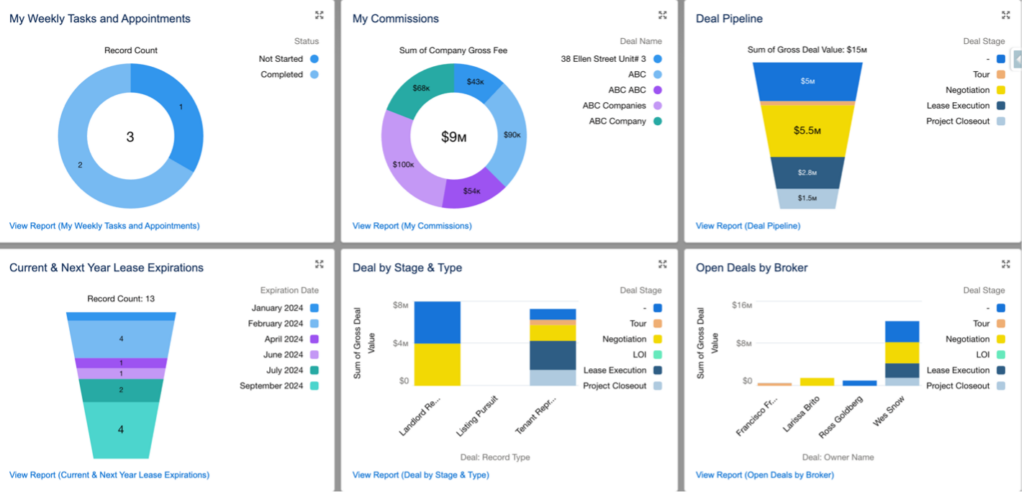
Consolidated Salesforce Reports for Real Estate Agents in a Single Dashboard | Ascendix
Information is always real-time, too, ensuring the most up-to-date figures for strategic decisions and progress oversight. Also, reports can be conveniently stored and structured in folders.
As a result, workflow, retention, conversion, and analytics improve. In fact, companies that have adopted Salesforce report a 34% increase in sales productivity. With Salesforce CRM’s features and benefits, your sales team will not overlook any lead and will catch every opportunity.
CRM and Salesforce are not the same thing. The initial vision was to create a cloud-based CRM, but they created not just software but a platform – a much more flexible and scalable thing.
Continuing to seek an analogy with iOS, CRM is running on the top of the Salesforce platform, like Safari on top of iOS. We can’t say that iOS is a Safari, so Salesforce and CRM shouldn’t be considered the same, too. Salesforce features mentioned above align with CRM system functionality, but those are only a part of extensive Salesforce capabilities available on other clouds and thanks to various add-ons.
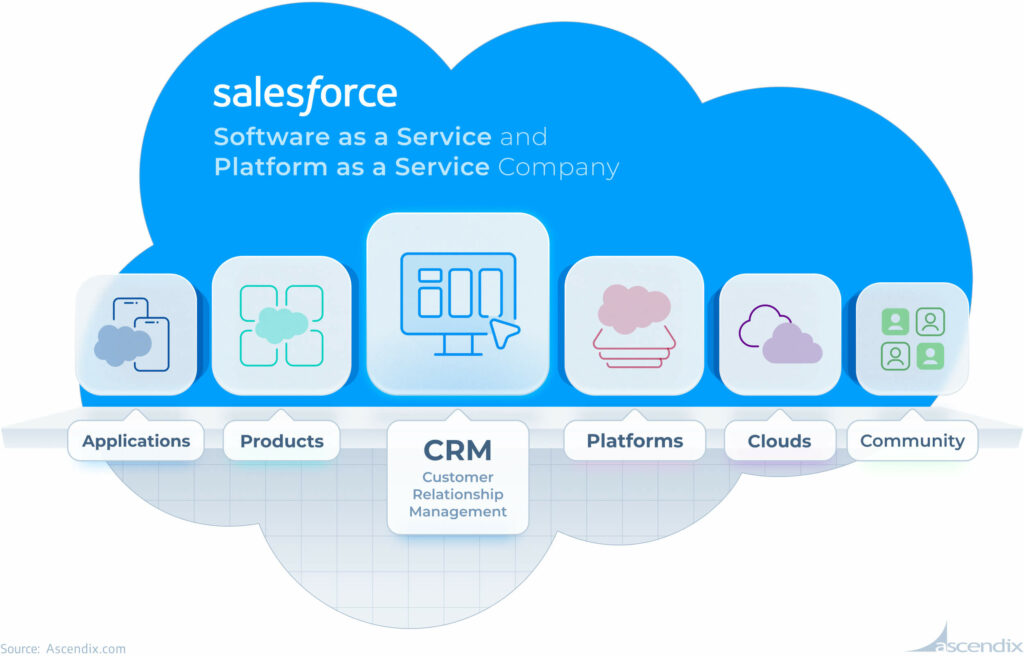
Nevertheless, Salesforce is the world’s #1 CRM, excelling Microsoft Dynamics 365, HubSpot, Zoho, Monday CRM, and others. Customization, scalability, robust data security, and the ability to seamlessly integrate other products and apps are top benefits of Salesforce CRM, whereas typical CRM systems are quite limited in those aspects.
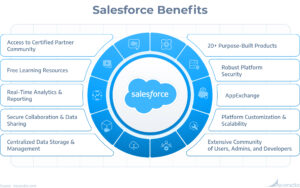
Benefits of Salesforce | Ascendix
Top Salesforce characteristics include its customizability, flexibility, agility, and scalability. Salesforce is not software but a platform that can be tailored to specific business needs. Changing user interface, creating custom fields and objects, custom workflows, and automations are easier with Salesforce low-code or no-code development tools.
When we talk about Salesforce’s robust security, we mean unbreakable multi-level security standards and protocols that ensure data protection with multi-factor authentication, data encryption, 24/7 monitoring and audit, and advanced Transport Layer Security.
AppExchange is an AppStore in the Salesforce universe. In this app marketplace, you can find and install on-demand business applications that are specially tailored to your needs. Here, you can find a suitable solution among more than 4.500 third-party apps.
Also, the applications on AppExchange are checked by Salesforce according to specific requirements and standards so users can trust their security and compatibility with the platform. They will seamlessly integrate with the Salesforce platform since they are developed on its basis. It’s like they speak in one language.
However, some apps are not free, can be quite expensive, and have a steep learning curve.
Salesforce provides a centralized repository for data storage with a single source of truth to avoid data silos and inconsistencies. Manage customer data, interactions, and sales processes with relevant information stored in one location for easy access and analysis.
Get an Expert Consultation Today.
The Salesforce document management system is designed for a more secure and productive document workflow. Users can access and work with files from any device at any time, while the system ensures versioning, rights control, convenient search and filtering, and more. This way, all important and classified documents like contracts, price lists, or product specifications are kept secure and up-to-date.
Salesforce allows separate permissions for secure data access for every object, field, and level. Consider an object a table in the database, a field a column, and a record a row. This way, you can give different rights to your team members for separate items.
Since one of the key points of Salesforce is boosting business growth with insights about customers’ behavior, conversion causes and deal-breakers to make proactive changes into your sales processes.
Salesforce provides six main clouds: Sales Cloud, Marketing Cloud, Commerce Cloud, Service Cloud, Experience Cloud, and Analytics Cloud. Each is designed for different needs, and there are even clouds for separate industries like Health Cloud, Financial Services and Energy & Utilities Cloud.
Unfortunately, Salesforce does not provide a separate cloud for the real estate industry, but here, Ascendix will give you a hand with AscendixRE—a commercial real estate CRM on top of Salesforce.
Nevertheless, the Salesforce ecosystem constantly expands with new products and services, ensuring all users’ needs are met.
Another exciting product has been introduced recently – the Einstein 1 Platform. It aims to gather and connect all the customer data from major Salesforce products like Sales, Service, Marketing, Commerce as well as Data Cloud to show you a complete picture of your customers.
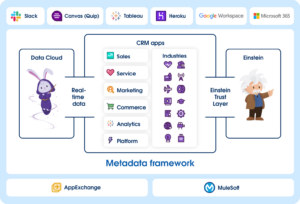
Einstein 1 Platform Structure | Salesforce
No matter how data is structured or distributed, the Einstein 1 Platform unifies them to create a clear view of your data across clouds, tools, and apps. It combines CRM, AI, Data, and Trust on one platform to significantly optimize the workflow. Changes you make in one app are immediately available everywhere.
Salesforce has a Certified Partner Community, which includes a wide range of partners with various levels of expertise and certifications. AppExchange alone has over 2,800 Salesforce Consultants. For every challenge, there is a Certified Salesforce Partner ready to help with expertise, guidance, and support.
Salesforce has an incredible free learning platform, Trailhead. It includes concise modules and interactive playgrounds for learning and trying out Salesforce features. Gamification makes the learning experience engaging and fascinating, encouraging users to continue exploring all Salesforce capabilities. In addition, you can find numerous educational materials from Salesforce partners like YouTube tutorials, guides, and ebooks.
Whenever you encounter a problem, you can always receive support from the worldwide community of Trailblazers—Salesforce users, admins, and developers. You will feel understood and find a solution to every issue together.
Contact Us and Make Salesforce Benefit Your Business Today.
Businesses benefit from Salesforce with streamlined sales, marketing, and customer service processes, but those are only scratches on the surface. A seasoned Salesforce consultant that understands your business needs will help you maximize Salesforce benefits. Ascendix is not just Certified, but Crest (formerly Gold) Salesforce Partner and belong to only 10-15% of consultancies managed to achieve this tier.
Contact Ascendix if you need help with Salesforce implementation, integration, development, system assessment, migration, customization, or consultation with a trustworthy Crest Salesforce partner.
The first step to getting Salesforce benefits is understanding your business needs and how Salesforce can help you fulfill them. Ascendix can help you with that as well as with setting up all the necessary integrations, optimizing existing processes, integrating necessary third-party tools, systems and apps, or creating custom solutions for your business.
The Salesforce ecosystem provides many tools, applications, and third-party integrations. Use AppExchange for secure and seamless app integration. Also, consider engaging other Salesforce products like Pardot to automate your marketing or any other Salesforce acquisitions.
Educate your team to familiarize them with useful Salesforce features. Informative modules and interactive playgrounds on the Trailhead platform will be effective gamified training for your team. Use educational materials from Salesforce partners to gain insights. If you still have questions, join the Trailblazers community to find the answers.
Salesforce delights its users with major platform updates thrice yearly on Winter, Spring and Summer releases. Stay up-to-date and seize new opportunities for your business.
Salesforce benefits for businesses include increased productivity, improved customer satisfaction, and enhanced data insights. It streamlines sales, marketing, and customer service processes and offers scalability, integration with other tools, and mobile accessibility. Also, businesses can use AI-powered predictions and recommendations to develop forward-thinking business strategies.
Salesforce’s core functionality includes Sales Forecasting, Contact and Account Management, Lead and Opportunity Management, Quote Management, Pipeline Management, Activity Management, Workflow and Approvals Automation, Reports and Dashboards, Campaign Management, and Sales Collaboration. However, they are only the top of the Salesforce features list.
The key point of Salesforce is to provide a cloud-based, scalable, and customizable platform for managing customer relationships and driving business growth through improved sales, marketing, and customer service processes.
No, CRM and Salesforce are not the same thing. CRM (Customer Relationship Management) is a system for managing customer interactions and data, while Salesforce is a cloud-based software platform that includes CRM, marketing, and customer service tools, as well as sales automation, analytics, and collaboration features.
Kateryna is an experienced writer focused on topics related to Salesforce consulting and optimizing operations within the real estate industry via CRM implementation. Through her insightful articles, Kateryna aims to help organizations make the most of their Salesforce adoption.